eOrganic author:
Dr. Mark Schonbeck, Virginia Association for Biological Farming
Introduction
Redroot pigweed, smooth pigweed, and Powell amaranth are three closely-related amaranths that have become serious cropland weeds throughout the United States and into southern Canada. The three species are discussed together because they are difficult to distinguish from one another in the field, have similar life cycles and habits of growth, and present similar management challenges in crop production.
Redroot pigweed (Figs. 1 and 2a), smooth pigweed (Fig. 2b), and Powell amaranth (Fig. 2c) are tall, erect, branching summer annuals that reach heights of 3–6 feet and occasionally more (Old, 2008). Stems and leaves may be smooth and hairless, or covered with fine hairs. Leaves are diamond-shaped to oval or egg-shaped with the broader end nearest the petiole (ovate). The leaf blades taper to rounded or pointed tips, have wavy to smooth margins, and are 1–6 inches long by 0.4–3 inches wide. The distinctly red or pink taproot and lower stem for which redroot pigweed was named is not a definitive characteristic of this species, as other Amaranthus species, including smooth pigweed and Powell amaranth, sometimes show similar coloration.

Figure 1. Redroot pigweed, showing habit of growth of mature plants with seed heads. Photo credit: Joseph M. DiTomaso, University of California–Davis, Bugwood.org
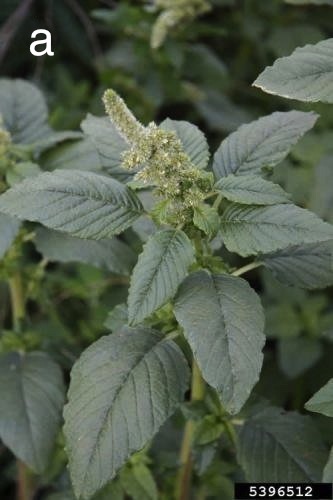
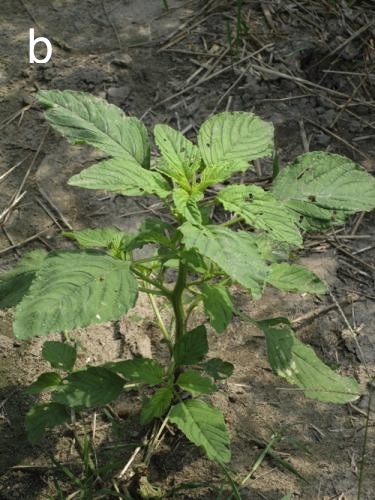
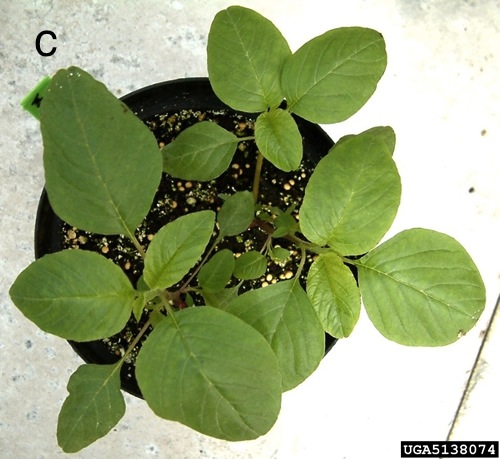
Figure 2.(a) Redroot pigweed foliage and developing flower head. (b) Smooth pigweed foliage. (c) Foliage of young Powell amaranth plants. Photo credits: (a) Robert Vidéki, Doronicum Kft., Bugwood.org, (b) Mark Schonbeck, Virginia Association for Biological Farming, (c) Lynn Sosnoskie, University of Georgia, Bugwood.org.
Male and female flowers are borne together on the same plant (monoecious). Individual flowers are small (<0.25 inch), inconspicuous, and clustered tightly in terminal inflorescences (flower heads) on main stems and major branches. Smaller inflorescences may also occur in upper leaf axils. Each female flower matures into a dry fruit (capsule) containing a single, small (0.04–0.05 inch diameter), dark red to black, shiny seed (Fig. 3).

Figure 3. Mature fruits and seeds of smooth pigweed. Figure credit: Lynn Sosnoskie, University of Georgia, Bugwood.org.
Redroot pigweed forms terminal inflorescences up to 8 inches long by 0.5–2 inches wide (Bryson and DeFelice, 2009). The inflorescence has a stiff, rough texture (hence the other common name for this species, "rough pigweed"), and consists of a much-branched spike with individual branches usually less than 2 inches long, and thicker than a pencil (Horak et al., 1994) (Fig. 4a and 4b). The inflorescence of smooth pigweed is similar in size and degree of branching, but has a much softer texture (hence, "smooth pigweed"), and individual branches usually no thicker than a pencil (Horak et al., 1994) (Fig. 4c). In Powell amaranth, inflorescences are linear or sparingly branched, with branches 4–8 inches long and thicker than a pencil (Horak et al., 1994) (Fig. 4d).
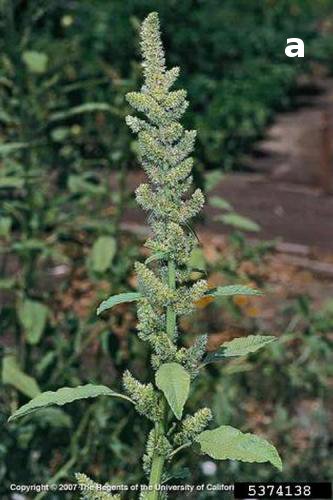
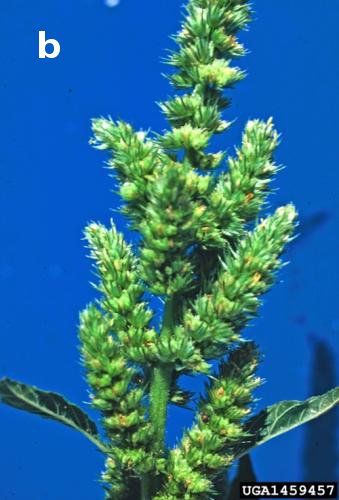
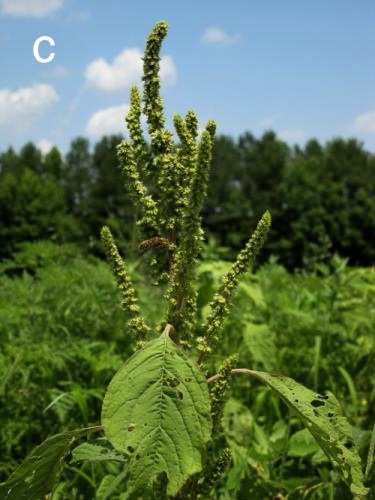
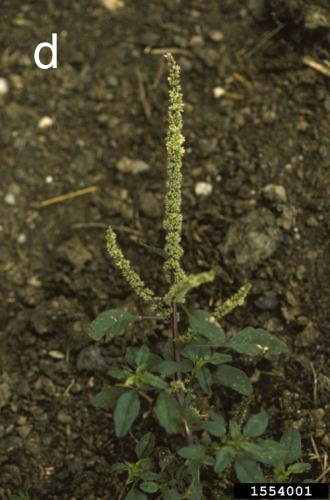
Figure 4. Flowering pigweeds. (a) Inflorescence of redroot pigweed. (b) Closeup of redroot pigweed inflorescence showing maturing seeds, and the long, stiff bracts which give the inflorescence its rough texture. (c) Smooth pigweed inflorescence. (d) Powell amaranth inflorescence. Photo credits: (a) Joseph M. DiTomaso, University of California - Davis, Bugwood.org. (b) Steve Dewey, Utah State University, Bugwood.org. (c) Mark Schonbeck, Virginia Association for Biological Farming. (d) Ohio State Weed Lab Archive, The Ohio State University, Bugwood.org.
Considerable genetic and morphological variability occurs within each of these three species, and field identification can be further complicated by occasional hybridization and gene flow among species. Definitive identification requires a closeup examination of the perianth (whorl of "tepals" or petal-like structures surrounding the fruit of the female flower) using a hand lens. In redroot pigweed, the tepals are all longer than the fruit itself; in smooth pigweed, they are all shorter than the fruit and have dark green mid-veins; and in Powell amaranth, tepals are very unequal in length with some longer and some shorter than the fruit (Costea et al., 2004).
Redroot pigweed and smooth pigweed are native to North America and Central America, occurring as pioneer plants of riparian regions, while Powell amaranth is native to dry, mountainous regions in the southwestern United States and Mexico (Costea et al., 2004; Flora of North America). Redroot and smooth pigweeds have spread throughout temperate regions around the world, and their long-standing reputation as troublesome summer annual weeds has led to an extensive body of research on their seed dormancy and germination, plant growth characteristics, competition with crops, and response to control tactics. Powell amaranth is now naturalized throughout temperate North America (Flora of North America; Mohler and DiTommaso, unpublished; Weaver and McWilliams, 1980), and its abundance relative to other pigweeds has increased in crop fields in Ontario, Canada (Weaver, 1984).
In recent years, several more aggressive amaranths have superseded redroot and smooth pigweeds as top concerns among farmers in some areas, including Palmer amaranth in the South (Fugate, 2009), waterhemp in the Midwest (Horak and Loughin, 2000), and Powell amaranth in the northeastern United States and Canada (Weaver, 1984).
Biology
The genetic variability and phenotypic plasticity (ability to vary in form or growth habit in response to environmental conditions) within each of these three species, and their potential to hybridize with each other and other weedy amaranths likely contributes to the capacity of these weeds to adapt to different environments, climates, production systems, and control tactics. Furthermore, studies showing apparent differences among the three species in seed dormancy and germination, growth characteristics, or physiological responses may reflect traits of the particular population studied, rather than the species as a whole. However, reviews of multiple studies show that smooth pigweed is better adapted to warmer climates and lower latitudes, whereas Powell amaranth is best adapted and most aggressive in cool-temperate regions of the northern United States and southern Canada (Costea et al., 2004; Weaver and McWilliams, 1980).
Pigweeds have the C4 photosynthetic pathway, which gives them an ability to grow and develop rapidly in high temperature and high light conditions. In field studies in the central United States, redroot and smooth pigweeds reached 2–3 inches within 2–3 weeks after planting (WAP), and 18–27 inches by 5–7 WAP (Horak and Loughin, 2000; Sellers et al, 2003). Whereas another pigweed species, Palmer amaranth, showed much higher growth rates, redroot pigweed is more tolerant of cool temperature regimes (Guo and Al-Khatib, 2003). In growth chamber experiments conducted under two day/night temperature regimes (72°F / 57°F, and 82°F / 72°F), and in field trials in Ontario, Canada, Powell amaranth germinated and grew more rapidly–and produced more seed–than either redroot pigweed or smooth pigweed (Weaver, 1984). In the northeastern United States, Powell amaranth emerges at lower temperatures and demonstrates more tolerance for light frosts than other pigweeds (Mohler and DiTommaso, unpublished).
A single, large, mature plant of redroot pigweed, smooth pigweed, or Powell amaranth can produce well over 200,000 seeds (Brainard and Bellinder, 2004; Sellers et al., 2003). Seed maturation generally occurs a few weeks earlier in Powell amaranth and northern populations of redroot pigweed than in smooth pigweed; thus, the former two species are better able to complete their life cycle within a short frost-free season.
Seed germination in redroot and smooth pigweeds is promoted by high temperatures (86–104°F), diurnally fluctuating temperatures (e.g., 59°F / 95°F), and light (Guo and Al-Khatib, 2003; Schonbeck and Egley, 1980; Steckel et al., 2004)–stimuli which are related to proximity to the soil surface and absence of shading vegetation. Freshly formed seeds require higher temperatures than seeds that have overwintered in the soil (Mohler and DiTommaso, unpublished; Schonbeck and Egley, 1981). Illinois populations of Powell amaranth seeds germinated fairly rapidly (in 1.5–3 days) over a wide temperature range (59–95°F), and showed relatively little additional response to diurnal temperature fluctuations (Steckel et al., 2004). Germination responses may vary depending on the age of the seeds, and the geographical location or production system from which they were collected. For example, seeds from Powell amaranth growing on dairy farms in upstate New York with a corn – alfalfa (multi-year) rotation were more dormant and longer lived than Powell amaranth seeds from fields under intensive vegetable production (Brainard et al., 2007).
All three pigweed species emerge mostly from seeds in the top 0.5 inch of the soil profile, and rarely from below 1 inch. Although seed longevity in soil up to 20 years has been reported, the majority of seeds either germinate or become nonviable within several years after they are shed. Deeper burial in the soil profile enhances seed dormancy and longevity in redroot pigweed (Omami et al., 1999). In Mississippi, redroot pigweed seeds buried 4 inches deep (from which seedlings cannot emerge) in field conditions showed a 93% loss of viability within 8 months (Schonbeck and Egley, 1981). However, in Nebraska, 7% of seeds buried at a depth of 8 inches remained viable after 12 years, and 1% after 17 years (Burnside et al., 1996), and other studies have also shown greater longevity in the soil in cooler climates (Costea et al., 2004).
The abundance of redroot, smooth, or Powell amaranths in crop fields appears more influenced by weed management practices, nutrient management, and crop rotation than by tillage, and these weeds may become troublesome in zero-till, conservation-till, and conventional tillage systems (Costea et al., 2004). In a field study in Colorado, preventing seed production for six consecutive years reduced existing redroot pigweed seed populations in the soil by 99 percent (Schweizer and Zimdahl, 1984). When weed control was discontinued after three years, the pigweed seedbank level recovered to more than half of the starting level by the end of the study. Fall moldboard plowing in plots with high seed populations reduced redroot pigweed emergence the following spring by more than 90 percent (from 3,500 to 250 per 10 square feet), but plowing fields in which seed production had been prevented for six years brought deeply buried seeds to the surface, and thereby increased emergence from 1 to 25 per 10 square feet.
Impact on Crops
Redroot pigweed, smooth pigweed, and Powell amaranth are major weeds of agronomic and horticultural crops throughout temperate North America, and as far north as Ontario, Canada (Knezevic et al., 1994, Weaver and McWilliams, 1980).
Pigweeds that emerge with the crop and are not controlled can substantially reduce crop yields (Fig. 5), and may overtop lower growing vegetables, causing a crop loss. Economic thresholds (weed levels that cause a 5% yield loss) for pigweeds emerging with corn and soybean crops have been estimated as low as 0.2–0.5 plants per 10 square feet, and 2–4 plants per 10 square feet for weeds emerging after crop seedlings have several leaves (Costea et al., 2004). In Ontario, redroot pigweed that emerged in corn at the 3–5-leaf stage at populations of 0.5–2.5 weeds per foot of row reduced yields 10–30%, whereas pigweed emerging at the 7-leaf stage had little effect (Knezvic et al., 1994).
During weed-crop competition, pigweeds respond to partial shading by increasing stem growth and deploying foliage at greater heights above the ground, thereby enhancing light interception. Redroot pigweed emerging with crops demonstrated this response in field trials in Ontario; however, higher levels of shade (due to higher crop population, or later weed emergence relative to the crop), greatly reduced the weed's growth and development (McLachlan et al., 1993a, 1993b). Powell amaranth grown with broccoli or broccoli + rye intercrop during a warm season responded to canopy shade with increased stem growth, whereas in a cooler season, the weed was more readily suppressed by crop competition (Brainard et al., 2005).
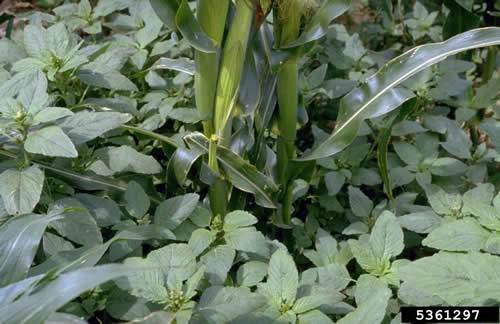
Figure 5. The redroot pigweed emerged shortly after the corn, and has already significantly reduced corn yield potential. Photo credit: Phil Westra, Colorado State University, Bugwood.org.
Pigweeds have been described as weeds of rich soils (Weaver and McWilliams, 1980), as high levels of readily available nitrogen (N) and phosphorus (P) seem to stimulate weed growth and nutrient uptake, and to intensify competition against crops. Redroot pigweed competes more aggressively against crops at high levels of soil nitrate-N, whereas high levels of ammonium-N seem to inhibit the weed (Blackshaw and Brandt, 2008; Teyker et al., 1991). Fertilization has been reported to triple seed production by redroot pigweed, and to stimulate growth and seed production in Powell amaranth in the northeastern United States (Mohler and DiTommaso, unpublished). Application of composted chicken manure shifted the competitive balance between Powell amaranth and cowpea in favor of the weed (Brainard et al., 2011). The early growth of redroot pigweed seedlings is more severely limited by low levels of available soil phosphorus (P) and potassium (K) than that of many other weeds, and much more so than large-seeded crops like corn, soybean, and cotton (Hoveland et al., 1976). However, the competitive effects of smooth pigweed on lettuce has been attributed by the weed's rapid uptake of soil P (Santos et al., 1998).
Studies in Florida indicate that heavy canopy-forming summer cover crops such as cowpea, velvetbean, and sunn hemp can suppress the growth of smooth pigweed, provided that cover crops are planted in narrow rows and sufficiently high seeding rates to promote early canopy closure (Collins et al., 2008). In New York, a summer cover crop of cowpeas with sorghum-sudangrass or Japanese millet suppressed Powell amaranth growth and seed production, whereas the weed outcompeted cowpea alone in a hot, dry year (Brainard et al., 2011). A buckwheat green manure suppressed the emergence and growth of Powell amaranth, partly by taking up available soil N, and partly by releasing allelopathic compounds from decaying buckwheat residues (Kumar et al., 2008, 2009).
There is some evidence that pigweeds may reduce crop yields through allelopathy. Soil incorporation of redroot pigweed was shown to reduce growth and yield of durum wheat significantly in Jordan (Qasem, 1995).
Management Implications for Organic Production
The organic weed management strategy outlined in the general article on pigweeds should be effective on Powell amaranth, smooth pigweed, and redroot pigweed. Try to get a positive identification of the species present, and be aware that Powell amaranth may grow more rapidly in the northern United States, and smooth pigweed more so further south. In warmer climates, positive identification is important to verify that the weed present is indeed one of these species and not Palmer amaranth or waterhemp, which are particularly aggressive in the South and the Corn Belt respectively, and may require more intensive, multi-tactic management strategies.
Although all pigweeds compete vigorously against crops, seedlings of Powell, smooth, and redroot pigweeds (Fig. 6) remain small and vulnerable to cultivation, rotary hoeing, or flame weeding for 2–3 weeks after emergence. Timely cultivations or flame weeding during late spring and early summer, followed by organic mulch, have been found effective for managing Powell amaranth in upstate New York (Mohler and DiTommaso, unpublished), and are likely equally effective for smooth and redroot pigweeds. Many cultivation implements can be adjusted to move sufficient soil into rows of established crops to bury within-row pigweed seedlings that are less than 1 inch tall.
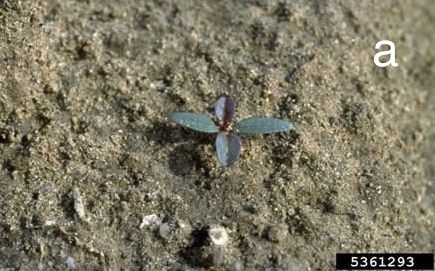
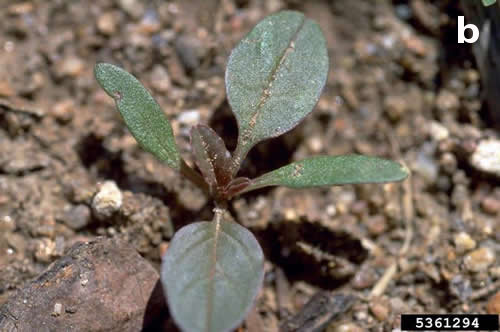
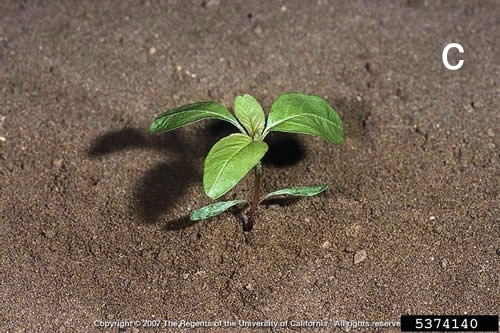
Figure 6. Pigweed seedlings. (a) Two-leaf stage of redroot pigweed, easily killed by shallow cultivation or flame weeding. (b) Redroot, (c) Powell, and (d) smooth pigweeds photographed about two weeks after emergence at the 4-leaf stage and about 1 inch tall. These are still susceptible to flaming or cultivation, but will become much tougher to control if allowed to grow beyond this stage. Photo credit: (a) Phil Westra, Colorado State University, Bugwood.org; (b) Phil Westra, Colorado State University, Bugwood.org. (c) Joseph M. DiTomaso, University of California-Davis, Bugwood.org, (d) Mark Schonbeck, Virginia Association for Biological Farming.
Because of the great genetic variability, adaptability, and hybridization potential of these three weeds, populations at different locales may respond differently to temperature, other germination stimuli, and weed control tactics. In addition, local populations are likely to adapt and become more competitive if the same weed management strategies are utilized year after year. It is especially important to design crop rotations that vary the timing and intensity of soil-disturbing field operations, and the seasons at which a plant canopy is absent (i.e., at and shortly after planting). The goal is to "keep the weed guessing" by varying the timing of cultivation, crop competition, and other stresses on the weed population.
Summer cover crops and green manures provide a competitive canopy during the season of greatest emergence and growth of these three pigweeds. Choose locally adapted cover crop varieties, and plant a combination of grass and legume for greatest competition against emerging weeds.
Although reducing tillage may not in itself lower pigweed populations or help in the management of these weeds, surface residues of winter cover crops rolled down for no-till planting of a subsequent production crop may be quite effective. In addition to the "mulching effect" (reduced light and thermal germination stimuli at the soil surface, plus physical impedance of emerging seedlings), residues of rye and wheat release allelopathic substances that can inhibit pigweed seed germination for several weeks without affecting the growth of a transplanted or large-seeded crop.
Manage nutrients to favor the crop over pigweeds. Slow-release sources of nutrients, such as well-ripened compost, are less likely to stimulate pigweed growth by releasing large amounts of nitrate or soluble phosphorus into the soil than faster-release sources like manure or blood meal. When applying more concentrated nutrient sources to heavy-feeding vegetables, band the material in the crop row to avoid feeding between-row weeds. Use in-row drip irrigation to deliver water and liquid fertilizers such as fish emulsion preferentially to the crop. Avoid broadcast applications of chicken litter or other concentrated nutrient sources, as these will stimulate rapid early growth of pigweeds, which may take up most of the nutrients before the crop can access them.
Minimize pigweed seed banks by preventing seed formation. For high value crops, it pays to manually remove any large pigweeds that have escaped early season cultivation, flame weeding, or mulching before they can form mature seed–as soon as you see flower heads start to form, if not sooner. Close mowing or weed-whacking between crop rows can greatly reduce seed formation, though axillary buds at basal leaf nodes on the stem can regenerate side shoots and thereby set seed. Severing pigweed plants below the cotyledonary node (i.e., at or just below ground level) can prevent shoot regeneration (Costea et al., 2004).
Uncomposted manure is a common source of pigweed seeds. Studies on redroot pigweed seeds have shown that dry seeds can tolerate brief exposure to temperatures as high as 158°F (Egley, 1990), but that composting (moist heat) at 130-150°F for four weeks reduces viability to zero (Tompkins et al., 1998). To avoid adding weed seeds to crop fields, raw manure and any other organic materials that may contain viable pigweed seeds should be hot-composted for at least four weeks, with several turns to ensure thorough heating of all the material, before application.
This article is part of a series discussing biology and management of invasive pigweeds in organic vegetable production. For more information, see the following articles:
- Weed Profile: Pigweeds (Amaranthus spp.)
- Spiny Amaranth (Amaranthus spinosus)
- Palmer Amaranth (Amaranthus palmeri)
References and Citations
- Blackshaw, R. E., and R. N. Brandt. 2008. Nitrogen fertilizer rate effects on weed competitiveness is species dependent. Weed Science 56:743–747. (Available online at http://dx.doi.org/10.1614/WS-08-065.1) (verified 25 June 2013).
- Brainard, D. C., and R. R. Bellinder. 2004. Assessing variability in fecundity of Amaranthus powellii using a simulation model. Weed Research 44: 203–217. (Available online at http://onlinelibrary.wiley.com/doi/10.1111/j.1365-3180.2004.00392.x/abstract) (verified 25 June 2013).
- Brainard, D. C., R. R. Bellinder, and V. Kumar. 2011. Grass-legume mixtures and soil fertility affect cover crop performance and weed seed production. Weed Technology 25: 473–479. (Available online at http://dx.doi.org/10.1614/WT-D-10-00134.1) (verified 2 Oct 2019).
- Brainard, D. C., R. R. Bellinder, and A. DiTommaso. 2005. Effects of canopy shade on the morphology, phenology, and seed characteristics of Powell amaranth (Amaranthus powellii). Weed Science 53: 175–186. (Available online at https://doi.org/10.1614/WS-04-067R1) (verified 27 Dec 2019).
- Brainard, D. C., A. DiTommaso, and C. L. Mohler. 2007. Intraspecific variation in seed characteristics of Powell Amaranth (Amaranthus powellii) from habitats with contrasting crop rotation histories. Weed Science 55: 218–226. (Available online at http://dx.doi.org/10.1614/WS-06-134.1) (verified 25 June 2013).
- Bryson, C. T., and M. S. DeFelice. 2009. Weeds of the South. University of Georgia Press, Athens, GA.
- Burnside, O. C., R. G. Wilson, S. Weisberg, and K. G. Hubbard. 1996. Seed longevity of 41 weed species buried 17 years in eastern and western Nebraska. Weed Science 44:74–86. (Available online at: http://www.jstor.org/stable/4045786) (verified 25 June 2013).
- Collins, A. S., C. A. Chase, W. M. Stall, and C. M. Hutchinson. 2008. Optimum densities of three leguminous cover crops for suppression of smooth pigweed (Amaranthus hybridus). Weed Science 56:753–761. (Available online at: http://dx.doi.org/10.1614/WS-07-101.1) (verified 25 June 2013).
- Costea, M., S. E. Weaver, and F. J. Tardif. 2004. The biology of Canadian weeds. 130. Amaranthus retroflexus L., A. powellii S. Watson, and A. hybridus L. Canadian Journal of Plant Science 84: 631-668. (Available online at: http://pubs.aic.ca/doi/abs/10.4141/P02-183#citart1) (verified 25 June 2013).
- Egley, G. H. 1990. High-temperature effects on germination and survival of weed seeds in soil. Weed Science 38: 429–435. (Available online at: http://www.jstor.org/stable/4044899) (verified 25 June 2013).
- Flora of North America. eFloras 2011 [Online]. Missouri Botanical Garden, St. Louis, MO & Harvard University Herbaria, Cambridge, MA. Smooth Pigweed. Available at http://www.efloras.org/florataxon.aspx?flora_id=1&taxon_id=200006982 Powell amaranth. Available at: http://www.efloras.org/florataxon.aspx?flora_id=1&taxon_id=242415662.
- Fugate, L. 2009. Pigweed causing farmers to rethink farming methods. University of Arkansas Cooperative Extension Service.
- Guo, P., and K. Al-Khatib. 2003. Temperature effects on germination and growth of redroot pigweed (Amaranthus retroflexus), Palmer amaranth (A. palmeri), and common waterhemp (A. rudis). Weed Science 51:869–875. (Available online at: http://dx.doi.org/10.1614/P2002-127) (verified 25 June 2013).
- Horak, M. J., and T. M. Loughin. 2000. Growth analysis of four Amaranthus species. Weed Science 48:347–355. (Available online at: http://dx.doi.org/10.1614/0043-1745(2000)048[0347:GAOFAS]2.0.CO%3B2) (verified 25 June 2013).
- Horak, M. J., D. E. Peterson, D. J. Chessman, and L. M. Wax. 1994. Pigweed identification: A pictorial guide to the common pigweeds of the Great Plains. Cooperative Extension Service, Kansas State University. (Available online at: http://www.ksre.ksu.edu/bookstore/Item.aspx?catId=236&pubId=1754) (verified 25 June 2013).
- Hoveland, C. S., G. A. Buchanan, and M. C. Harris. 1976. Response of weeds to soil phosphorus and potassium. Weed Science 24: 194–201. (Available online at: http://www.jstor.org/stable/4042586) (verified 25 June 2013).
- Knezevic, S. Z., S. F. Weise, and C. J. Swanton. 1994. Interference of redroot pigweed (Amaranthus retroflexus) in corn (Zea mays). Weed Science 42: 568–573. (Available online at: http://www.jstor.org/stable/4045456) (verified 25 June 2013).
- Kumar, V., D. C. Brainard, and R. R. Bellinder. 2008. Suppression of Powell amaranth (Amaranthus powellii), shepherd's-purse (Capsella bursa-pastoris), and corn chamomile (Anthemis arvensis) by buckwheat residues: Role of nitrogen and fungal pathogens. Weed Science 56: 271–280. (Available online at: http://dx.doi.org/10.1614/WS-07-106.1) (verified 25 June 2013).
- Kumar, V., D. C. Brainard, and R. R. Bellinder. 2009. Suppression of Powell amaranth (Amaranthus powellii) by buckwheat residues: Role of allelopathy. Weed Science 57: 66–73. (Available online at: http://dx.doi.org/10.1614/WS-08-028.1) (verified 25 June 2013).
- McLachlan, S. M., C. J. Swanton, S. F. Weise, and M. Tonnenar. 1993a. Effect of corn-induced shading and temperature on rate of leaf appearance in redroot pigweed (Amaranthus retroflexus L.). Weed Science 41: 590–593. (Available online at: http://www.jstor.org/stable/4045427) (verified 25 June 2013).
- McLachlan, S. M., M. Tollenaar, C. J. Swanton, and S. F. Weise. 1993b. Effect of corn-induced shading on dry matter accumulation, distribution, and architecture of redroot pigweed (Amaranthus retroflexus). Weed Science 41: 568–573. (Available online at: http://www.jstor.org/stable/4045424) (verified 25 June 2013).
- Mohler, C. A., and A. DiTommaso. Unpublished. Manage weeds on your farm: A guide to ecological strategies. Department of Crop and Soil Sciences, Cornell University. Pre-publication draft, version 5.1. Publication anticipated in 2012.
- Old, R. 2008. 1,200 Weeds of the 48 states and adjacent Canada: Interactive identification guide [DVD]. XID Services, Inc., Pullman, WA.
- Omami, E. N., Haigh, R. Medd, and Nicol. 1999. Changes in germinability, dormancy, and viability of Amaranthus retroflexus as affected by depth and duration of burial. Weed Research 39: 345–354. (Available online at: http://dx.doi.org/10.1046/j.1365-3180.1999.00149.x) (verified 25 June 2013).
- Qasem, J. R. 1995. The allelopathic effect of three Amaranthus spp. (pigweeds) on wheat (Triticum durum). Weed Research 35: 41–49. (Available online at: http://dx.doi.org/10.1111/j.1365-3180.1995.tb02015.x) (verified 25 June 2013).
- Santos, B. M., J. A. Dusky, W. M. Stall, and D. G. Shilling. 1998. Phosphorus effects on the competitive interactions of smooth pigweed (Amaranthus hybridus) and common purslane (Portulaca oleracea) with lettuce (Lactuca sativa). Weed Science 46: 307–312. (Available online at: http://www.jstor.org/stable/4045866) (verified 25 June 2013).
- Schonbeck, M. W., and G. H. Egley. 1980. Redroot pigweed (Amaranthus retroflexus) seed germination responses to afterripening, temperature, ethylene, and some other environmental factors. Weed Science 28:543–548. (Available online at: http://www.jstor.org/stable/4043277) (verified 25 June 2013).
- Schonbeck, M. W., and G. H. Egley. 1981. Changes in sensitivity of Amaranthus retroflexus L. seeds to ethylene during preincubation. II. Effects of alternating temperature and burial in soil. Plant, Cell and Environment 4:237–242. (Available online at: http://dx.doi.org/10.1111/1365-3040.ep11611005) (verified 25 June 2013).
- Schweizer, E. E., and R. L. Zimdahl. 1984. Weed seed decline in irrigated soil after six years of continuous corn (Zea mays) and herbicides. Weed Science 32: 76–83. (Available online at: http://www.jstor.org/stable/4043886) (verified 25 June 2013).
- Sellers, B. A., R. J. Smeda, W. G. Johnson, J. A. Kendig, and M. R. Ellersieck. 2003. Comparative growth of six Amaranthus species in Missouri. Weed Science 51: 329–333. (Available online at: http://dx.doi.org/10.1614/0043-1745(2003)051[0329%3ACGOSAS]2.0.CO%3B2) (verified 25 June 2013).
- Steckel, L. E., C. L. Sprague, E. W. Stoller, and L. M. Wax. 2004. Temperature effects on germination of nine Amaranthus species. Weed Science 52:217–221. (Available online at: http://dx.doi.org/10.1614/WS-03-012R) (verified 25 June 2013).
- Teyker, R. H., H. D. Hoelzer, and R. A. Liebl. 1991. Maize and pigweed response to nitrogen supply and form. Plant and Soil 135: 287–292. (Available online at: http://dx.doi.org/10.1007/BF00010918) (verified 25 June 2013).
- Tompkins, D. K., D. Chaw, and A. T. Abiola. 1998. Effect of windrow composting on weed seed germination and viability. Compost Science and Utilization 6: 30–34. (Available online at: https://doi.org/10.1080/1065657X.1998.10701906) (verified 27 Dec 2019).
- Weaver, S. E. 1984. Differential growth and competitive ability of Amaranthus retroflexus, A. powellii and A. hybridus. Canadian Journal of Plant Science 64: 715–724. (Available online at: http://dx.doi.org//10.4141/cjps84-098) (verified 25 June 2013).
- Weaver, S. E., and E. L. McWilliams. 1980. The biology of Canadian weeds. 44. Amaranthus retroflexus L, A. powellii S. Wats and A. hybridus L. Canadian Journal of Plant Science 60: 1215–1234. (Available online at: http://dx.doi.org/10.4141/cjps80-175) (verified 25 June 2013).



